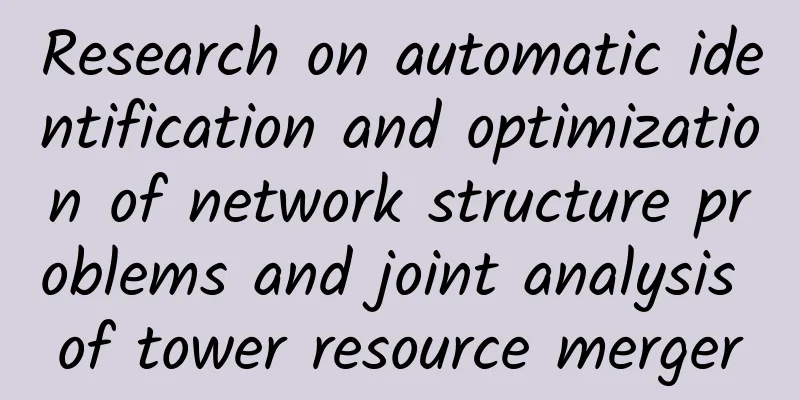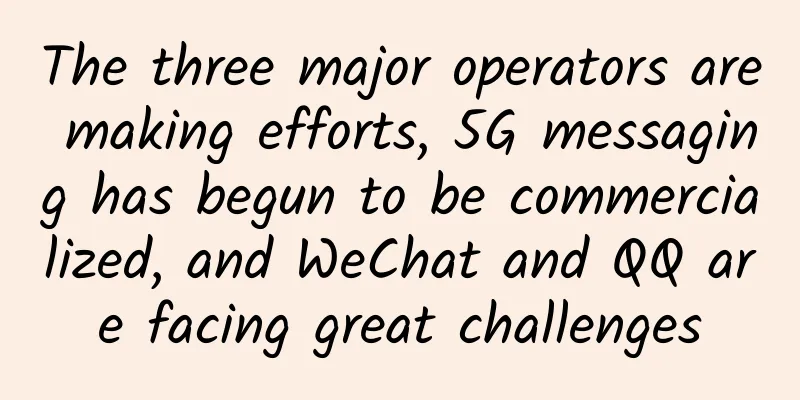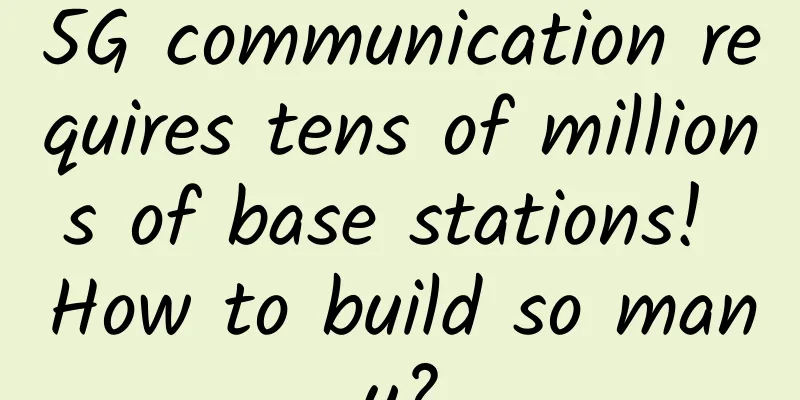Research on automatic identification and optimization of network structure problems and joint analysis of tower resource merger

|
Author: Han Binjie and Liu Hongxing, unit: Hebei Mobile Labs GuideAs the scale of 5G network construction expands, the cost of tower service fees will rise accordingly. Hebei Mobile has established the concept of zero growth in tower service fees in 2022. On the basis of leveraging the advantages of large-scale construction and professional operation, it continues to launch site cost reduction and efficiency improvement activities. The rent of the tower is related to the number of operators using the antenna. That is, the more operators use it, the cheaper the rent will be. Therefore, when relocating, the current mobile resources can be integrated with nearby tower resources to effectively reduce operating costs. The 5-year service fee window for the tower will be in 2022, and no depreciation fee will be paid to the tower company after the lease is terminated. It is very important to complete the evaluation of the tower resource integration effect this year. Based on the current situation, this project strives to calculate the coverage effect before and after the relocation through coverage analysis of the existing website. Combined with coverage analysis and competitor & self-owned tower site deployment, we carried out multi-tower merger of our company's exclusive sites and competitor sites, from exclusive to merger, and after on-site investigation and evaluation, we merged sites without affecting user perception. Combined with coverage and network structure analysis, we carried out relocation and rectification of sites with structural problems and super idle sites to meet the needs of building macro sites. 1. Work Background
2 Main technical innovationsWireless MR data is used to compensate for MR coverage around pre-idle stations and evaluate the MR coverage effect after idleness. The main technical innovations include MR migration algorithm, MR transformation algorithm innovation, MR differential algorithm tools, etc. 2.1 MR Migration AlgorithmScreening of independent mobile sites and competing sites to match and output of multi-tower merging candidate sites, MR coverage evaluation before and after site removal, and MR coverage evaluation of sites after merging, mainly divided into two steps; Step 1: Calculate the volume of the weak coverage grid caused by the demolition of the original station Statistical rules of the variation grid within the effective coverage radius: 1) The grid-level frequency variation after demolition was more than 10% higher than before demolition. 2) The frequency value before demolition is greater than -90dBm, and the frequency value after demolition is less than -90dBm. 3) No MR grid information was collected after the site was dismantled. 4) If the above problem grids are repeated, they will be recorded as "1" weak coverage grid, and only the union grids with deterioration within the effective coverage range will be calculated. Step 2: Conduct a second rule evaluation on the weak coverage grid caused by the removal of the original station 5) Multi-tower merger: The target station can cover more than 70% of the newly added poor-quality grids after the original station is decommissioned. 6) Inefficient demolition: the proportion of poor quality grids after demolition is less than 20% or the proportion of covered grids before demolition is less than the number of grids in the total area*3%.
Example Multiple towers merge Before the merger: the number of grids was 200; after the merger: the number of grids was 200, one grid had weak coverage due to the merger, and five grids had deteriorated due to the merger. The merger of sites resulted in a total of 6 grids with weak coverage and deterioration, accounting for 3%. Site merger can be performed. Inefficient demolition Before the merger: the number of grids was 474, after the removal: the number of grids was 467, of which 7 grids had weak coverage due to the removal, and 1 grid had deteriorated due to the removal, resulting in a total of 8 grids with weak coverage and deterioration, accounting for 2%, and the site can be removed. 2.2 MR Transformation Algorithm InnovationThe MR transformation algorithm innovatively realizes the coverage estimation after demolition and merging, which mainly includes three parts: first, the final position of the MR sampling point is determined by the WCCL positioning algorithm; second, the backfill neighboring area after demolition is matched by the neighboring area backfill algorithm; third, the MR transformation algorithm innovatively simulates the actual coverage effect after relocation. 2.2.1 WCCL positioning algorithmThe WCCL positioning algorithm mainly relies on MR and engineering parameters, and is based on the comprehensive application of ranging geometric positioning and weighted centroid geometric positioning. The former comprehensively determines the UE candidate position through the intersection of the MR measured delay (or the propagation model to construct the camouflaged delay) and the direction angle. The latter constructs a polygon through the MR measurement cell and calculates the topological centroid based on the level weighting as the UE spatial candidate position. Finally, the results of the two positioning methods are combined to determine the final position of the MR sampling point. Figure1 Schematic diagram of WCCL positioning principle 2.2.2 WCCL positioning algorithm neighboring area backfill algorithm① Get the frequency of the serving cell: Period Intra Freq Measurement Report/SerCarrierFreq. The frequency of the serving cell in the same-frequency measurement report is also the frequency of the neighboring cell. ② Obtain the eNodeBId-CellID of the neighboring cell: traverse each neighboring cell in the Period Intra Freq Measurement Report/NeighCellRst, obtain the localCellID of the primary service cell in the cell table through the CellID, and find the corresponding neighboring cell table through the localCellID. Obtain the corresponding neighboring cell CellID by associating the neighboring cell table with PhysCellId + the above-determined SerCarrierFreq. If it is not found, find the corresponding eNodeBId-CellID in the engineering parameter table index through PhysCellId + the above-determined SerCarrierFreq. 2.2.3 MR transformation algorithm innovation simulates the actual coverage effect after relocationBy collecting the matched PhysCellId information, the MR innovation under the existing base station is adjusted and transformed to simulate the actual coverage effect after relocation. The MR difference (link budget) before and after the transformation is mainly related to the model selection, equipment parameters, and the calculation of industrial parameter differences.
The link budget calculation formula is: receiving level = transmitting power + antenna gain - path loss - comprehensive loss - system margin The main parameters involved are as follows: The path loss Lpath is calculated according to the SPM model as follows: Lpath=K1+k2log(d)+k3log(Heff)+k4Diff+K5log(d)log(Heff)+K6Hms+Kclutter*f(clutter)+Khill,los annotation: ① When the diffraction factor and the ground object loss factor are not considered, the link budget difference of the MR level before and after the base station relocation is calculated, and the MR after the relocation is differentially corrected to approximately obtain the value of the MR of the base station after the relocation. ② When performing differential calculation on the MR data before and after the relocation, since the topographic difference of the base station location before and after the relocation is small, most of the losses in the link budget can be ignored. After calculation, the MR level difference ∆R = MR before relocation - MR after relocation ≈ antenna gain difference + path loss difference; The antenna gain difference is related to the horizontal and vertical angles between the user and the antenna; ③The path loss difference is related to the distance between the user and the base station, the height difference, and the signal propagation model. 2.3 Development and application of MR difference algorithm toolsAlthough the MR transformation algorithm can be used to simulate the MR data after migration, the coverage scenario, application frequency band, antenna height, etc. of the relocated site are different from those of the original site, which will cause differences in the simulated data. By independently compiling the MR difference algorithm tool, by inputting information such as frequency band, coverage area, height, and direction angle, the MR coverage difference before and after the relocation is estimated, and the MR simulation data after migration is corrected. The main steps are as follows: Step 1: In the input interface, enter the base station information before and after relocation and perform calculations. Step 2: Calculate the antenna gain in each direction based on the antenna parameters and direction angle. Step 3: Calculate the path loss difference based on the propagation model and engineering parameter information. Step 4: Output data - Based on the link budget and engineering parameter information, calculate the MR difference value centered on the relocation point for use in MR migration simulation. 3. Explanation on the scalability of the resultsThe effective integration of tower resources solves the problems of difficult site selection, high cost and low efficiency, and helps reduce problems such as coverage interference in the network structure, ultimately achieving the results of reducing operating costs and increasing network comprehensive benefits while ensuring network coverage. Combined with the site improvement in 2021, the merger of towers can save 2.838 million yuan, and the removal of inefficient towers can save 3.289 million yuan. |
<<: WonderShaper: Network card speed limit tool
>>: Discussion on interactive control technology of device platform based on gateway
Recommend
The biggest risk of 5G networks
The fifth generation (5G) network has the potenti...
MIIT releases 5G spectrum planning, China launches mid-band 5G commercialization
On November 15, the Ministry of Industry and Info...
CrownCloud: $5/month KVM-2GB/30GB/2TB/Los Angeles & Germany & Netherlands & Atlanta
The tribe has shared news about CrownCloud many t...
Eurocloud newly launched AS9929 line high defense in Los Angeles Cera data center with 50% discount starting from $2.5/month
At the end of last month, OULUCLOUD launched a ne...
iWebFusion: US servers starting from $45/month, in Los Angeles/North Carolina/Bend/Monticello and other data centers
iWebFusion (iWFHosting) is a subsidiary of the ve...
Port reuse So_Reuseaddr
Port reuse is a classic problem in network progra...
OneTechCloud: 25.2 yuan/month KVM-1GB/20G SSD/5M unlimited traffic/Hong Kong CN2
OneTechCloud is a Chinese hosting company establi...
Analysis of global 5G infrastructure market development trends from 2020 to 2027
Market research firm Grand View Research recently...
Ransomware cannot be prevented? "Dynamic security defense" + "key data backup"
Recently, a well-known domestic financial softwar...
Several thinking patterns that need to be changed in the 6G era
First of all, 5/6G is born for the interconnectio...
F5 Networks Appoints Adam Judd to Lead APAC Sales Efforts to Accelerate Growth of Cloud and Security Business in the Region
Beijing, March 21, 2017 – Today, F5 Networks anno...
Data Cabling: How to Plan Ahead?
Data cabling is an important channel for enterpri...
4G network speed slows down? Ministry of Industry and Information Technology talks with three operators on this issue
On the 22nd, the Ministry of Industry and Informa...
[5.1] Megalayer VPS 50% off, Hong Kong E3 server from 299 yuan/month, Singapore dual E5 server from 499 yuan/month, optional CN2/optimized bandwidth
Megalayer has officially launched a May Day promo...
The edge computing dilemma of operators in the 5G era
With the continuous development of 5G, 5G will be...








![[Black Friday] FlipperHost: 2GB memory KVM monthly payment starts at $4.9, 4 data centers in Los Angeles and other places](/upload/images/67cac473c3319.webp)
